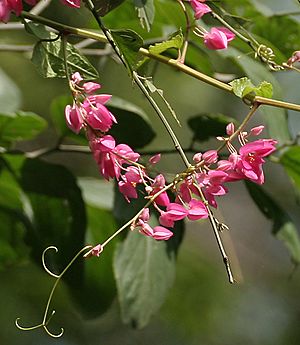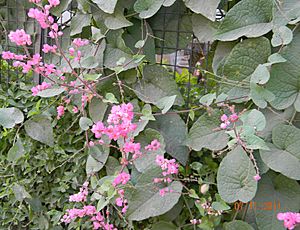Antigonon leptopus facts for kids
Quick facts for kids Antigonon leptopus |
|
|---|---|
 |
|
| Scientific classification | |
| Genus: |
Antigonon
|
| Species: |
leptopus
|
| Synonyms | |
|
|
Antigonon leptopus is a type of perennial vine often called coral vine or queen's wreath. It belongs to the buckwheat family. This climbing plant has pretty, usually pink flowers. These flowers can bloom all year long. It also has large leaves shaped like hearts.
The coral vine comes from the coastal areas of Mexico. You can also find it growing wild along roadsides from Mexico down to Central America. It has been brought to many tropical places around the world. This includes parts of the United States, the West Indies, South America, Asia, and Africa. In some of these places, it has become an invasive plant. People use this plant for its edible tubers (like potatoes) and seeds. It is also grown as an ornamental plant because it looks nice.
Contents
About the Coral Vine
The coral vine (Antigonon leptopus) grows very fast. It is a climbing vine that uses thin parts called tendrils to hold on. It can grow longer than 7 meters (about 23 feet). Its leaves are shaped like hearts or sometimes triangles. They are usually 25 to 75 millimeters (1 to 3 inches) long.
The flowers grow in clusters along a main stem. They are pink or white and bloom from spring to autumn. This plant grows tubers underground and has large roots. It also makes many seeds. These seeds can float on water. Animals like pigs, raccoons, and birds eat and spread the fruit and seeds. If the plant is cut back or damaged by frost, its tubers can sprout new growth.
Different Names for the Coral Vine
This plant has many different common names. Here are some of them:
- Chamorro: cadena de amor, flores kádena.
- English: bride's tears, coral vine, Confederate vine, chain-of-love, hearts on a chain, Mexican creeper, mountain-rose coralvine, queen's wreath, queen's-jewels.
- French: liane antigone, liane corail, rosa-de-montana.
- Palauan: dilngau.
- Pohnpeian: rohsenpoak suwed.
- Portuguese: amor agarradinho.
- Spanish: bellísima, colación, confite, confitillo, corallita, corona, coronilla, flor de San Diego, San Miguel, San Miguelito.
- Tongan: 'ufi.
Where the Coral Vine Grows
Native Home
The coral vine is originally from the Atlantic and Pacific coastlines of Mexico. On the Pacific side, it grows in places like Baja California Sur and Sonora. On the Atlantic side, it is found in Tamaulipas. Its natural range goes south and inland through different Mexican states.
This plant likes sandy soils and does not grow well in shady spots. In Baja California Sur, it naturally grows in dry riverbeds, canyons, and on hillsides. The vine climbs over cacti and trees. It can also cover shrubs and rocks. It grows in many different environments there, from islands and deserts to mountains and lowlands. You can also see it growing along roadsides and fences in Mexico.
Where It Has Spread
Outside of Mexico, the coral vine is an invasive plant in many tropical areas. It is especially known for causing problems on island ecosystems. You can find it on all tropical continents and even on far-off islands in the Pacific Ocean.
Scientists believe the coral vine was brought to these new places many times. This happened from different seed sources. People often grow the plant as an ornamental. This is usually how it spreads to new areas. However, not all places where it's introduced become invasive. Sometimes, it just stays as a cultivated plant.
The coral vine prefers disturbed areas, forest edges, roadsides, and rocky cliffs. It can grow in full sun or partial shade. It also tolerates poor soils. In the wet season, it can grow so much that it smothers native plants. In the dry season, it can lose its leaves to survive drought. These dry leaves can then become fuel for wildfires. When the soil is disturbed, its tubers can spread. Its seeds also spread easily because they float on water.
How People Use the Coral Vine
Long ago, the native people of Baja California Sur used to prepare Antigonon leptopus seeds. They cooked them in a way similar to making popcorn. They put the seeds in a flat basket made of flexible twigs. Then, they placed hot coals on top of the seeds. They shook the basket with both hands. This made the coals toast the seeds without burning the basket.
Once the seeds were toasted, they removed the burnt coals. Many of the seeds would burst open, showing a white inside. They then separated the seeds from their husks. They did this by tossing them into the air with the basket. This is like how farmers separate wheat from chaff. The toasted seeds were then ground into a meal and eaten. Sometimes, the seeds were boiled and made into fried cakes.
Coral Vine as an Invasive Plant
In Florida, the coral vine is listed as a category II invasive exotic plant. This means it is a non-native plant that causes harm to the environment.
On the Caribbean island of St. Eustatius, the coral vine has caused big changes. It has increased the number of arthropods (like insects and spiders). It also made the communities of arthropods more similar. Before the vine invaded, arthropod groups in developed and natural areas were different. After the vine invaded, they became hard to tell apart.
The vine also changed how these communities worked. Invaded areas had more nectar-eating, plant-eating, and detritus-eating arthropods. Some animals, like ants, seemed to suffer from the invasion. The vine's growth also led to fewer predatory lizards of the genus Anolis.
See also
 In Spanish: Antigonon leptopus para niños
In Spanish: Antigonon leptopus para niños



